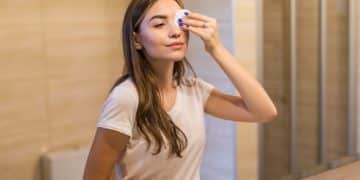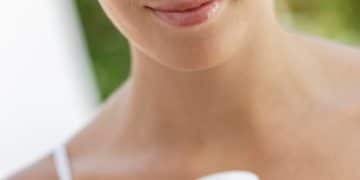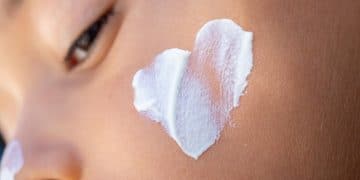How to Get Rid of Wrinkles: Your Comprehensive Guide to Youthful Skin
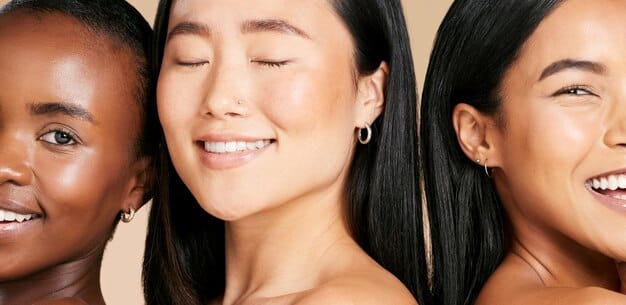
Anúncios
Achieving smoother, younger-looking skin involves a multifaceted approach, combining advanced treatments, effective skincare routines, and lifestyle adjustments to reduce the appearance of wrinkles and promote skin health.
For many, the appearance of fine lines and wrinkles is an inevitable hallmark of aging, a reflection of time and natural processes. However, understanding how to get rid of wrinkles is not merely about finding a magic cure; it’s about embracing a strategic approach that combines scientific advancements with consistent daily practices. This comprehensive guide delves into the most effective methods, from topical treatments to advanced clinical procedures, empowering you to address and mitigate the visible signs of aging.
Understanding Wrinkles: The Science Behind Skin Aging
Wrinkles, those creases and folds in our skin, are a natural part of the aging process. Yet, their formation is a complex interplay of internal and external factors. Understanding these underlying mechanisms is the first step in effectively combating their appearance.
Internally, the primary culprits are a decrease in collagen and elastin production. Collagen provides skin with its firmness, while elastin gives it elasticity and the ability to snap back. As we age, our bodies produce less of these vital proteins, leading to a loss of skin structure and resilience.
Intrinsic Aging Factors
Genetics play a significant role in how and when wrinkles appear. Some individuals are simply predisposed to developing wrinkles earlier due to their inherited skin type and cellular repair mechanisms. Hormonal changes, particularly during menopause, can also accelerate skin aging by reducing estrogen levels, which are crucial for maintaining skin hydration and elasticity.
- Cellular Turnover: The rate at which new skin cells replace old ones slows down with age.
- Fat Loss: Subcutaneous fat, which gives skin a plump, youthful appearance, diminishes over time.
- Bone Resorption: Changes in underlying bone structure can lead to skin laxity and wrinkles.
Extrinsic Aging Factors
While intrinsic aging is unavoidable, extrinsic factors, largely environmental, significantly accelerate the process. These are the elements we can largely control or mitigate. Sun exposure is by far the most damaging, with UV radiation breaking down collagen and elastin fibers, leading to photoaging.
Smoking constricts blood vessels, reducing oxygen and nutrient delivery to skin cells. Pollution exposes skin to free radicals, causing oxidative stress. A poor diet lacking in antioxidants and essential nutrients can also compromise skin health.
- UV Radiation: Causes photoaging, leading to hyperpigmentation and deep wrinkles.
- Smoking: Reduces blood flow, depleting skin of vital oxygen and nutrients.
- Pollution: Generates free radicals, damaging skin cells and collagen.
- Poor Diet: Lacks essential vitamins and antioxidants necessary for skin repair.
Understanding these intricate factors, from the genetic blueprint to the daily environmental onslaught, provides a foundation for choosing the most effective strategies to manage and reduce the visibility of wrinkles. It’s a battle on multiple fronts, but one that can be won with knowledge and consistent effort.
Topical Treatments: Your First Line of Defense
When it comes to addressing wrinkles, topical treatments are often the most accessible and popular starting point. The market is saturated with anti-aging creams and serums, but understanding the key ingredients and their mechanisms is crucial to making informed choices.
These products work by delivering active compounds directly to the skin, aiming to stimulate collagen production, enhance cell turnover, and provide antioxidant protection. Consistency in application is paramount to seeing noticeable results over time.
Retinoids: The Gold Standard
Retinoids, derivatives of Vitamin A, are arguably the most well-researched and effective topical ingredients for wrinkle reduction. They work by increasing cell turnover, stimulating collagen synthesis, and improving skin texture and tone. Tretinoin (prescription-strength retinoid) is particularly potent, while retinol (over-the-counter) is a milder option.
When introducing retinoids, it’s advisable to start with a lower concentration and gradually increase frequency to minimize irritation. Sun protection is also essential, as retinoids can increase skin sensitivity to UV light.
Antioxidants: Protecting Your Skin
Antioxidants combat free radical damage, a major contributor to premature aging. Vitamin C, E, and ferulic acid are powerful antioxidants that protect skin from environmental aggressors like pollution and UV radiation. Vitamin C, in particular, also plays a role in collagen production.
Incorporating antioxidant serums into your morning routine can offer an additional layer of protection beneath your sunscreen, while evening applications can aid in skin repair.
Hyaluronic Acid: Hydration and Plumping
While not directly targeting wrinkles like retinoids, hyaluronic acid (HA) dramatically improves skin hydration and plumpness. It attracts and holds up to 1,000 times its weight in water, helping to fill in fine lines temporarily and give skin a smoother appearance. Hydrated skin looks healthier and more youthful.
- Peptides: Small chains of amino acids that signal skin to produce more collagen.
- Alpha Hydroxy Acids (AHAs): Exfoliate the skin, promoting cell turnover and improving texture.
- Niacinamide (Vitamin B3): Reduces inflammation, improves skin barrier function, and minimizes pore appearance.
Choosing the right topical treatments requires patience and a willingness to experiment to find what works best for your skin type. Combining different active ingredients, such as a retinoid at night and an antioxidant serum in the morning, can yield synergistic benefits.
Advanced Treatments: Clinical Solutions for Deeper Wrinkles
For those seeking more dramatic results or looking to address deeper wrinkles, advanced clinical treatments offer powerful solutions. These procedures are typically performed by dermatologists or licensed medical professionals and can range from minimally invasive injections to laser therapies.
Understanding the options available and setting realistic expectations is crucial when considering these interventions. A thorough consultation with a qualified professional will help determine the most suitable approach for your specific concerns.
Injectables: Botox and Fillers
Botox (botulinum toxin) is renowned for treating dynamic wrinkles—those caused by muscle movement, such as crow’s feet and frown lines. It temporarily relaxes the underlying muscles, smoothing out the appearance of these wrinkles.
Dermal fillers, typically made of hyaluronic acid, are used to restore lost volume, plump up static wrinkles (those present at rest), and enhance facial contours. They can address smile lines, marionette lines, and volume loss in the cheeks or lips.
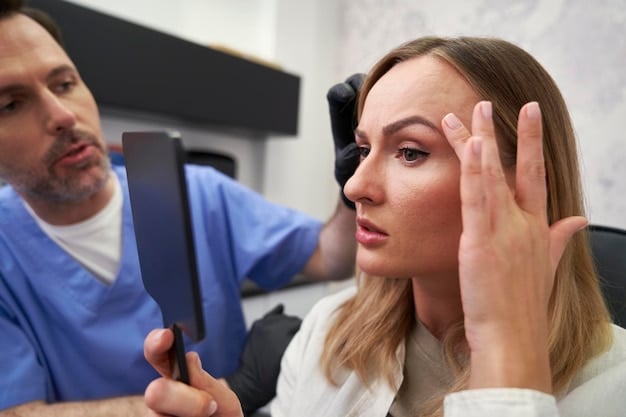
Laser Resurfacing: Skin Rejuvenation
Laser resurfacing treatments use concentrated beams of light to remove the outer layers of damaged skin, stimulating collagen production and revealing smoother, younger-looking skin underneath. Ablative lasers offer more dramatic results with longer downtime, while non-ablative lasers provide milder improvements with quicker recovery.
These treatments can significantly improve the appearance of deep wrinkles, sun damage, and uneven skin tone. Multiple sessions may be required for optimal results, and post-treatment care is essential for proper healing.
Chemical Peels: Exfoliation and Renewal
Chemical peels involve applying a chemical solution to the skin to exfoliate its outer layers, promoting cell turnover and revealing fresher skin. They range in strength from superficial to deep, with stronger peels offering more significant wrinkle reduction but also requiring longer recovery times.
Peels can improve fine lines, hyperpigmentation, and overall skin texture. They are often a good option for those looking for a non-surgical way to rejuvenate their complexion.
- Microneedling: Creates micro-injuries in the skin to stimulate collagen and elastin production.
- Ultherapy: Uses ultrasound energy to lift and tighten skin on the face, neck, and chest.
- Radiofrequency (RF) Therapy: Heats dermal layers to stimulate collagen and tissue tightening.
While advanced treatments offer powerful solutions, they should be approached with caution and conducted under expert supervision. Combining these procedures with consistent topical skincare and a healthy lifestyle can maximize and prolong their benefits.
Lifestyle and Prevention: Minimizing Wrinkle Formation
While topical creams and clinical treatments offer solutions for existing wrinkles, preventing their formation and minimizing their progression is equally important. Lifestyle choices play a pivotal role in skin health and can significantly impact how quickly and profoundly wrinkles develop.
Adopting healthy habits not only benefits your skin but also contributes to overall well-being. Proactive prevention is often the most effective long-term strategy in the battle against wrinkles.
Sun Protection: Your Best Defense
Unquestionably, the most impactful preventative measure against wrinkles is rigorous sun protection. UV radiation from the sun is the leading cause of premature aging, breaking down collagen and elastin fibers. Daily use of broad-spectrum sunscreen with an SPF of 30 or higher is non-negotiable, regardless of weather or season.
Further protecting yourself by seeking shade, wearing wide-brimmed hats, and donning UV-protective clothing significantly reduces sun exposure and prevents photoaging.
Hydration and Nutrition: Fueling Healthy Skin
Staying adequately hydrated by drinking plenty of water supports skin elasticity and plumpness, making fine lines less noticeable. A diet rich in antioxidants, vitamins, and healthy fats also provides the necessary building blocks for healthy skin.
Foods like berries, leafy greens, nuts, fatty fish, and avocados supply essential nutrients that combat oxidative stress and promote cellular repair. Limiting sugar and processed foods can also reduce inflammation, which can contribute to skin aging.
Sleep and Stress Management: Restoring and Repairing
Adequate sleep is crucial for skin repair and regeneration. During sleep, skin cells undergo a renewal process, and the body produces growth hormones that are vital for collagen production. Chronic sleep deprivation can lead to increased cortisol levels, which can break down collagen.
Similarly, chronic stress leads to elevated cortisol, impacting skin health. Incorporating stress-reducing practices like meditation, yoga, or hobbies can have a positive ripple effect on your complexion.
- Avoid Smoking: Smoking drastically ages skin by constricting blood vessels and depriving skin of oxygen.
- Limit Alcohol Consumption: Excessive alcohol dehydrates the body and can contribute to premature aging.
- Gentle Skincare: Avoid harsh scrubbing or pulling on your skin, which can create micro-tears over time.
Embracing these lifestyle adjustments creates a strong foundation for skin health, proactively working to delay the onset and progression of wrinkles. Prevention, often overlooked, is a cornerstone of any effective anti-aging strategy.
Holistic Approaches: Mind, Body, and Skin Connection
Addressing wrinkles goes beyond mere topical applications or clinical procedures; it encompasses a holistic philosophy that recognizes the profound connection between our internal well-being and external appearance. A truly comprehensive approach integrates mind, body, and emotional health to support vibrant skin.
True beauty, and by extension, skin health, is a reflection of overall vitality. By nourishing all aspects of our being, we can foster a complexion that not only looks younger but genuinely feels healthier and more resilient.
Mindfulness and Stress Reduction
Chronic stress triggers the release of cortisol, a hormone that can break down collagen and elastin, leading to premature aging. Practices like mindfulness meditation, deep breathing exercises, and yoga can significantly lower stress levels, reducing their detrimental impact on the skin.
Taking moments throughout the day for self-care and relaxation not only benefits mental health but also allows the skin to function optimally, promoting repair and regeneration.
Adequate Sleep for Skin Repair
Often referred to as “beauty sleep,” sufficient rest is fundamental. During sleep, our bodies repair and regenerate cells, including skin cells. Growth hormone production peaks during deep sleep, facilitating collagen synthesis and overall skin repair. A consistent sleep schedule and a restful environment contribute significantly to a healthier, more youthful complexion.
Regular Exercise and Circulation
Physical activity boosts blood circulation, delivering oxygen and nutrients more efficiently to skin cells while also helping to flush out toxins. This improved circulation can give the skin a healthy glow and support its ability to repair itself. Exercise also helps manage stress and can improve sleep quality, creating a virtuous cycle for skin health.
Hydration Beyond Topical Application
While topical hyaluronic acid is beneficial, internal hydration is paramount. Drinking adequate amounts of water throughout the day keeps skin cells plump and resilient, diminishing the appearance of fine lines and contributing to a healthier skin barrier. Herbal teas and water-rich foods also contribute to overall hydration.
- Gut Health: A healthy gut microbiome can influence skin radiance and reduce inflammation.
- Positive Outlook: Emotional well-being reflects on the face, contributing to a more vibrant appearance.
- Avoid Over-Washing: Excessive cleansing can strip natural oils, compromising the skin barrier.
Embracing a holistic approach means recognizing that wrinkles are not just a surface-level concern but often an indicator of internal processes. By nurturing our mind and body, we create an environment where our skin can thrive, leading to long-lasting improvements in its texture and appearance.
Customizing Your Anti-Wrinkle Routine: Personalized Skincare
There’s no one-size-fits-all solution for addressing wrinkles; effective skincare is deeply personal. Your skin type, age, lifestyle, and the severity of your concerns all play a role in determining the most effective routine. Customizing your approach ensures that you are providing your skin with exactly what it needs to thrive.
This personalized strategy involves attentive observation, informed choices, and patience. It’s about building a routine that adapts to your skin’s evolving needs, rather than blindly following generic advice.
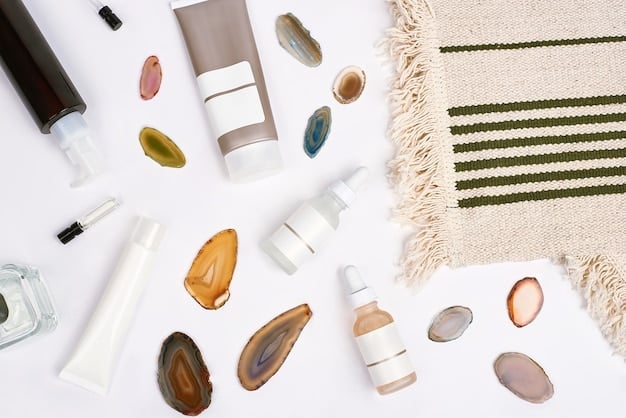
Assess Your Skin Type and Concerns
Before investing in products or treatments, understand your skin’s unique characteristics. Is it oily, dry, combination, or sensitive? Are your primary concerns fine lines, deep wrinkles, sun spots, or loss of firmness?
For oily or acne-prone skin, retinoids and AHAs can be particularly beneficial for both wrinkles and breakouts. Dry or sensitive skin may require milder formulations, emphasizing hydration and barrier support. Addressing specific concerns allows for targeted treatment.
Start Slowly and Be Consistent
Introducing new active ingredients, especially potent ones like retinoids, should be done gradually. Start with lower concentrations and apply them a few times a week, slowly increasing frequency as your skin adapts. Consistency is key; results from skincare products take time, often weeks or months, to become visible.
An effective routine isn’t about using many products, but about using the right products consistently.
Layering Products Effectively
The order in which you apply your skincare products matters. Generally, start with the thinnest consistency and move to the thickest. A common layering sequence includes:
- Cleanser: To remove impurities.
- Toner: To balance skin pH.
- Serum (e.g., Vitamin C, Hyaluronic Acid, Retinoid): Targeted treatments.
- Eye Cream: For delicate under-eye area.
- Moisturizer: To seal in hydration.
- Sunscreen (AM): Essential final step for daytime.
Consult a Dermatologist or Skincare Professional
For persistent concerns, severe wrinkles, or when considering advanced treatments, a qualified dermatologist or medical aesthetician is invaluable. They can accurately diagnose your skin condition, recommend prescription-strength options, and perform procedures safely and effectively.
Professional guidance can save you time and money by helping you avoid ineffective products and ensuring you receive treatments best suited for your individual needs. Building a personalized anti-wrinkle routine is an ongoing journey of learning and adaptation. By understanding your skin and making informed choices, you can achieve and maintain a complexion that reflects your best self.
| Key Anti-Wrinkle Strategy | Brief Description |
|---|---|
| ☀️ Sun Protection | Daily SPF 30+ is crucial to prevent UV damage and photoaging. |
| 🧪 Topical Retinoids | Stimulate collagen production and increase cell turnover for smoother skin. |
| 💧 Hydration & Diet | Proper water intake and antioxidant-rich foods support skin health. |
| 👩⚕️ Professional Treatments | Options like fillers, Botox, and lasers for deeper lines and volume loss. |
Frequently Asked Questions About Wrinkle Reduction
It’s generally recommended to start an anti-wrinkle routine in your mid-20s to early 30s as a preventative measure. Focusing on sun protection, hydration, and incorporating mild retinoids can significantly delay the appearance of fine lines. Early prevention is often more effective than attempting to reverse established wrinkles later.
While natural remedies like certain oils (e.g., argan, rosehip) and ingredients (e.g., green tea extract) can provide hydration and antioxidant benefits, they typically offer modest improvements for fine lines and skin health. They are unlikely to “remove” deeper wrinkles in the same way scientifically proven ingredients or clinical treatments can.
Patience is key. For most topical products, especially those containing active ingredients like retinoids, visible improvements can take anywhere from 6 to 12 weeks of consistent use. Deeper wrinkles may require longer, or benefit more from advanced clinical treatments. Individual results vary based on product concentration and skin type.
No, injectables like Botox are not permanent. Botox typically lasts 3 to 6 months, as its muscle-relaxing effects gradually wear off. Dermal fillers, while lasting longer depending on the type and area injected, also eventually break down and are absorbed by the body, requiring follow-up treatments to maintain results.
Yes, staying well-hydrated by drinking plenty of water helps maintain skin elasticity and plumpness. While it won’t erase deep wrinkles, adequate hydration can make fine lines appear less noticeable and contribute to overall skin health, giving it a more supple and youthful appearance from within.
Conclusion
Addressing wrinkles is a journey that integrates a deeper understanding of skin science with consistent, personalized care. From daily sun protection and potent topical ingredients like retinoids to advanced clinical interventions, a multifaceted approach offers the most promising path to a smoother, more rejuvenated complexion. Ultimately, a holistic view—encompassing lifestyle, nutrition, stress management, and expert guidance—empowers individuals to not only mitigate the visible signs of aging but also cultivate lasting skin health and vitality.

